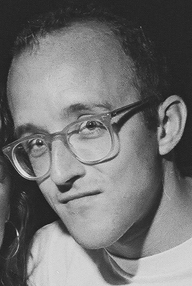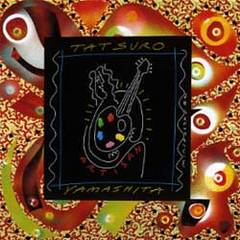Related Research Articles

Keith Allen Haring was an American artist whose pop art emerged from the New York City graffiti subculture of the 1980s. His animated imagery has "become a widely recognized visual language". Much of his work includes sexual allusions that turned into social activism by using the images to advocate for safe sex and AIDS awareness. In addition to solo gallery exhibitions, he participated in renowned national and international group shows such as documenta in Kassel, the Whitney Biennial in New York, the São Paulo Biennial, and the Venice Biennale. The Whitney Museum held a retrospective of his art in 1997.

Tatsurō Yamashita, occasionally credited as Tatsu Yamashita or Tats Yamashita, is a Japanese singer-songwriter and record producer often referred to as the "King of City Pop" for pioneering that style of Japanese adult-oriented rock/soft rock music. His most well-known song is "Christmas Eve", the best-selling single song released in Japan in the 1980s, appearing on the Japanese singles chart for over 35 consecutive years. He is known for his collaborations with his wife and popular singer Mariya Takeuchi on many songs including "Plastic Love" as well as with American songwriter Alan O'Day with whom he wrote hit songs "Your Eyes," "Magic Ways," "Love Can Go the Distance," and "Fragile." Active since the 1970s, Yamashita is considered an important contributor to Japanese music, ranked by HMV Japan as sixth in the Top 100 Japanese Artists.
Thierry Noir is a French artist and muralist based in Berlin. He is considered the first artist to paint the Berlin Wall in the 1980s. He created brightly-colored paintings across large spans of the Berlin Wall and some of these original paintings can still be seen on surviving segments of the Wall in art collections and on the East Side Gallery. Noir's work and style are now considered iconic, and Noir is also regarded as one of the forerunners of the street art movement as a whole. He continues to create murals worldwide in cities including London, Los Angeles, and Sydney.
Los Four was a Chicano artist collective active based in Los Angeles, California. The group was instrumental in bringing the Chicano art movement to the attention of the mainstream art world.

Arnold Belkin was a Canadian-Mexican painter credited for continuing the Mexican muralism tradition at a time when many Mexican painters were shifting away from it. Born and raised in western Canada, he trained as an artist there but was not drawn to traditional Canadian art. Instead he was inspired by images of Diego Rivera's work in a magazine to move to Mexico when he was only eighteen. He studied further in Mexico, focusing his education and his career mostly on murals, creating a type of work he called a "portable mural" as a way to adapt it to new architectural style. He also had a successful career creating canvas works as well with several notable series of paintings. He spent most of his life and career in Mexico except for a stay in New York City in the late 1960s to mid-1970s. His best known works are the murals he created for the University Autónoma Metropolitana in the Iztapalapa borough of Mexico City.
Donald K. Sultan is an American painter, sculptor, and printmaker, particularly well-known for large-scale still life paintings and the use of industrial materials such as tar, enamel, spackle and vinyl tiles. He has been exhibiting internationally in prominent museums and galleries, and his works are included in important museum collections all over the globe. Sultan is the recipient of numerous honors and awards for his artistic achievements.

Millard Owen Sheets was an American artist, teacher, and architectural designer. He was one of the earliest of the California Scene Painting artists and helped define the art movement. Many of his large-scale building-mounted mosaics from the mid-20th century are still extant in Southern California. His paintings are in the Metropolitan Museum of Art and the Whitney Museum in New York, the Chicago Art Institute, the National Gallery in Washington D.C.; and the Los Angeles County Museum.
Judith Francisca Baca is an artist, activist, and professor of Chicano studies, world arts, and cultures based at the University of California, Los Angeles. She is the co-founder and artistic director of the Social and Public Art Resource Center (SPARC) in Venice, California. Baca is the director of the mural project that created the Great Wall of Los Angeles, which is the largest communal mural project in the world.

Phibs is the nom de plume of Tim De Haan, a notable graffiti artist operating out of Sydney, Australia.

Artisan is the thirteenth studio album recorded by the Japanese singer-songwriter Tatsuro Yamashita. It was released in June 1991, led by a string of hit singles he produced. Artisan became his first album that was not released on LP. Like his 1989 live album Joy, illustration for a front cover of Artisan was drawn by Andre Miripolsky, who painted a cover art of Bette Midler's 1983 No Frills album. It debuted at the No. 1 on the Oricon, and spent 20 weeks on chart with sales of over 700,000 copies in total. In December 1991, the album won the 33rd Japan Record Awards for "Best Pop/Rock Album" and "Excellent Albums" prizes.
The Herron Arch 1, a public sculpture by American artist James Wille Faust, is located on the Indiana University-Purdue University Indianapolis campus, which is near downtown Indianapolis, Indiana. The sculpture is located at the corner of New York and Blackford Streets, the north-east corner of the Herron School of Art and Design. Faust, an alumnus of Herron, created the 20-foot-tall (6.1 m), vividly colored aluminum sculpture for Herron's eighteen-month-long Public Sculpture Invitational.

Thierry Guetta, best known by his moniker Mr. Brainwash, is a French-born Los Angeles-based street artist. According to the 2010 Banksy-directed film Exit Through the Gift Shop, Guetta was a proprietor of a used clothing store, and amateur videographer who was first introduced to street art by his cousin, the street artist Invader, and who filmed street artists through the 2000s and became an artist in his own right in a matter of weeks after an off-hand suggestion from Banksy.
Michael Cummings is an American artist and quilter who lives in Harlem, New York.

Alonzo Davis is an African-American artist and academic known for co-founding the Brockman Gallery in Los Angeles with his brother Dale Brockman Davis. In reaction to a perceived lack of coverage of black art, Davis became an advocate for black art and artists. His best-known work is the Eye on '84 mural he painted to commemorate the 1984 Summer Olympics.
Allison "Hueman" Torneros is a Filipino-American graffiti artist, painter, and illustrator, based in Oakland, California. Hueman's best-known works include Bloom, a mural in the Los Angeles Arts District commemorating community advocate Joel Bloom, and the cover artwork for Pink’s 2019 record, Hurts 2B Human. As street art is a medium dominated by men, Hueman is noted as a female artist who has achieved significant renown.

Hideo Date was a Japanese-born American painter active from the 1930s to the 1980s, known for combining elements of Japanese nihonga with American Synchromism. A prominent figure in the Los Angeles art scene prior to World War II, his career was interrupted by the wartime incarceration of Japanese Americans. Although he continued painting for decades after the war, Date's work remained largely ignored until he was rediscovered by a younger generation of artists and curators in the 1990s.
Tristan Eaton (1978) is an American artist. Primarily known for his toy designs and street art murals, Eaton is also a graphic designer and illustrator.
Jesse Hernandez is an American tattoo artist and graphic designer for video games and collectible toys. He was a part of the urban vinyl art movement of the 2010s. He was also the lead character and prop designer on United Front Games' ModNation Racers. His designs have been featured on Kidrobot's Dunny toys, including one owned by singer-songwriter Usher.
Sachio Yamashita (1933–2009) was a Japanese-American artist primarily known as the creator of more than 100 public murals throughout the Midwest between 1968 and 1982, and later as an abstract painter and muralist in the San Francisco Bay Area. As a muralist, Yamashita identified as an "environmental" artist "who creates, or alters environments." Chicago art historian Rebecca Zorach observes that Yamashita "showed how murals could be understood not just as community-based art but as huge environmental installations, breaking free from the gallery, changing city dweller's consciousness."
References
- ↑ Rodriguez, Monica (13 June 2008). "Father and son at the da". San Bernardino Sun. Archived from the original on 16 November 2018. Retrieved 31 May 2014.
- 1 2 Butler, Simone (22 April 1986). "Artist paints the story of his painful crash recovery". Los Angeles Times. Retrieved 31 May 2014.
- 1 2 3 4 Gaines, Malik (9 May 2000). "Brushes with greatness". Advocate. Retrieved 31 May 2014.
- 1 2 3 Faulkner, Rob (20 November 2003). "When pain and pop art meet; Andre Miripolsky's Fear No Art series is made up of brilliant, madcap collages of thought resulting from a near-fatal car crash in 1984". Hamilton Spectator.
- ↑ Hall, Trish (25 February 1990). "US designers find bright horizon in Japan". New York Times. Retrieved 31 May 2014.
- 1 2 3 4 5 "The Artist Today" (PDF). Los Angeles Arts Alliance. Retrieved 31 May 2014.
- ↑ Crawford Watson, Lisa (22 April 2011). "Renowned artist helps students add color, style to local history". Monterey Herald. Archived from the original on 31 May 2014. Retrieved 31 May 2014.
- ↑ "Andre Miripolsky 's colorful mural lights up downtown LA's Pershing Square". Los Angeles Examiner. 16 July 2012.